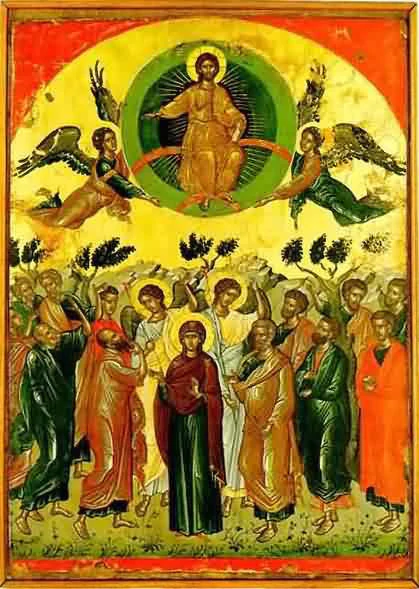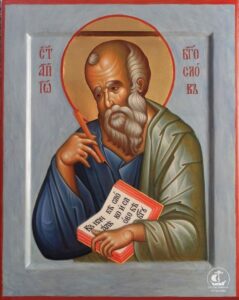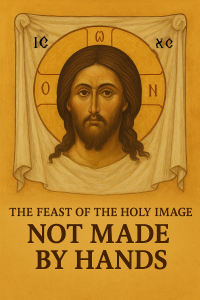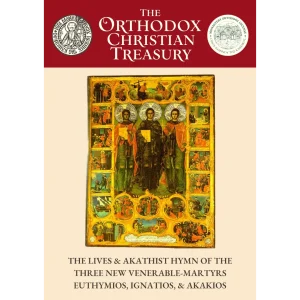FROM THE ASCENSION TO PENTECOST by Vladimir Moss

The period between the Ascension of the Lord and the Descent of the Holy Spirit at Pentecost is a very specific and unique period in the Church Year. The Ascension is clearly the supreme climax in the Life of Christ. The Resurrection takes place at night, is hidden, is not believed by all, is opposed by the Jews. There is unbelievable joy, but also fear. Forty days later, however, all doubts have been removed from the faithful; their joy is complete, unmixed by fear. The Lord ascends in glory, in the sight of all, both angels and men, to the furthest reaches of the cosmos and beyond, to the Right Hand of God the Father. What could be greater, what more glorious?
And yet something is missing. It is not the Lord Himself that is missing, for even while He disappears from visible sight into the heavens, He assures them with His blessing (which, according to the Holy Fathers, is never-ending) that He will be with them invisibly and spiritually for ever, to the very end of the world. Indeed, it is impossible to believe that their joy would be as great if they did not believe His promise of this without any shadow of doubt. But something is missing nevertheless…
What is missing, of course, is the gift of the Holy Spirit in His fullness, which the Lord said they would receive in ten days’ time in Jerusalem. But, it may be asked, had they not already received the gift of the Holy Spirit on the first evening of Pascha, when the Lord came through the locked doors and breathed on them, saying: “Receive ye the Holy Spirit”?
They had indeed received the Spirit; but the first reception at Pascha was different from the second reception at Pentecost.
The difference was explained by St. Gregory the Great in his Homilies on the Gospel as follows. At Pascha the apostles received the Holy Spirit as a strengthening and perfection of their unity as a body, the Body of Christ. The remitting of sins – that is, the sacrament of confession – was given together with this reception; for perfect unity is possible only when all sin has been removed, with the assurance that this Spirit-bearing Body has the capacity to remove all sin, all obstacles to unity between God and man and man and man, that may arise in it in the future. At Pascha, therefore, the Unity and Holiness of the Church is given. But at Pentecost there is given Her Catholicity and Apostolicity. The Spirit descends in separate tongues of fire upon each of the apostles, signifying those individual gifts of the Spirit that they will need in order to spread the Apostolic teaching to all the nations of mankind.
In the Gospel we find other distinctions between different bestowals of the Spirit. Thus during the Mystical Supper the Lord said: “If ye love Me, keep My commandments. And I will ask the Father, and He shall give you another Comforter, that He may abide with you for ever, even the Spirit of truth, Whom the world cannot receive, because it seeth Him not, neither knoweth Him; but ye know Him; for He dwelleth with you, and shall be in you” (John 14.15-17).
Here we find the doctrine of the Holy Trinity encapsulated into one sentence, with the separate Persons of the Father, the Son and the Holy Spirit, the Comforter, clearly indicated. Here also we find the aim of the Christian life, the acquisition of the Holy Spirit. And the assurance given to the apostles that they will attain that aim – the Holy Spirit will abide in them for ever.
The conditions of this gift are also indicated: fulfilment of the commandments, and separation from the world, which lies in evil and therefore cannot know God. As St. Theophylact of Ochrid writes, commenting on this passage: “What makes us able to know the Holy Spirit and to receive Him? The fact that you are not of this world…”
Finally, we are given a critical distinction between two modes in which the Holy Spirit communes with men: dwelling with them and dwelling in them. It is only the indwelling of the Spirit that saves us; this the apostles had not yet received at the time of the Mystical Supper, which is why the Lord uses the future tense: “He shall be in you”. However, even before the Holy Spirit dwells in us, He can dwell with us. This “with-dwelling” the apostles already had, which is why the Lord uses the present tense: “He dwelleth with you”. “With-dwelling” of the Spirit without His “indwelling” was the condition of the Old Testament saints, and of converts and catechumens who have received the gift of faith through the Holy Spirit, but have not yet received the Holy Spirit Himself in the sacrament of Chrismation.
The question arises: if we have received the Holy Spirit dwelling in us through the sacrament of Chrismation, why is it that St. Seraphim of Sarov says that the aim of the Christian life is to acquire the Holy Spirit? If we have already received the Holy Spirit, why do we still have to acquire it? The short answer to this is: just as we can acquire the Holy Spirit, so we can also lose it, which necessitates its re-acquisition. All sin brings with it a quenching of the Spirit, just as a lamp covered with a shade involves a quenching or diminution of light. We are called not to hide our light, the light of the Holy Spirit, under a bushel, the bushel of sin, but to put it in a prominent place so that it may illumine the whole room of our soul.
It is important not to be trapped, as it were, by spatial imagery here. The distinction between the “withdwelling” and the “indwelling” of the Spirit is a spatial image, which aids our understanding, but only takes us so far. God is not in space and time; so He is neither “inside” nor “outside” nor “next to” our soul in a literal way. Similarly, we can use the metaphor of the light of the Holy Spirit growing or diminishing in the soul, being “covered” by sin or “uncovered” by its removal. But all such images are metaphors that have real value (for it is impossible for human beings to think without images), but cannot be taken literally without leading to absurdities.
If we bear these limitations of human thinking and imagining in mind, then we can return to the metaphors without fear of apparent contradictions. Thus during Chrismation, on the one hand, the Christian receives the Holy Spirit within him, and he does not have to acquire it again. Unless, that is, he apostasizes from the faith, becoming, for example, a Muslim, after which he needs to be chrismated again on returning to the Church in order to receive the Holy Spirit he has lost. On the other hand, it is obvious that some Christians have the Spirit in much greater abundance than others. Thus the Saints, we can say, have acquired the Holy Spirit, whereas we sinners have to work very hard and repent very deeply in order to reach their level of spirituality. All Christians receive the same gifts in the holy sacraments. But some make use of the gift, and make it grow (as it were), while others bury it in the barren soil of their hardened hearts and bring forth no spiritual fruit.
Just as we receive the Holy Spirit in different modes or degrees, so we can lose Him in different modes and degrees. Thus in the Fall in the Garden of Eden, the Holy Spirit ceased to dwell in the souls and bodies of Adam and Eve and their descendants. Instead they put on “garments of skin” – that is, the death-bearing passions. “By a garment of this kind,” writes the Anglo-Saxon Father, the Venerable Bede, “the Lord signifies that they had now been made mortal – the skins contain a figure of death because they cannot be drawn off without the death of the animal”. It also indicated that their animal nature now “covered”, or obscured, their spiritual nature.
However, while the Spirit ceased to be in men, as part of their constitution, as it were, so that they became “sensual [psychikoi, literally “psychical”], deprived of the Spirit” (Jude 19), He did not cease to be with them. This is seen in the fact that God continued to talk openly with men – good men such as Enoch, who “walked with God” (Genesis 5.24), and even bad men, like Cain. But as the spiritual condition of mankind deteriorated, and especially after the mysterious episode in which the “sons of God” began to take wives from the daughters of men, God made a further judgement: “My Spirit shall certainly not remain in these men for ever, because they are flesh. Instead they will have a life of 120 years” (Genesis 6.4 (Septuagint translation)). “Because they are flesh” – that is, according to St. John Chrysostom, “on account of their devoting themselves to carnal pleasures and not employing properly the properties of the soul, but passing their life as if they were clad in flesh alone and had no soul”. Since the Uncreated Spirit was no longer in or with the souls of men, the created breath of life would be withdrawn from all living creatures: they would be destroyed in the Flood. Moreover, after the Flood the span of men’s lives would be sharply reduced. Noah, who “found grace in the eyes of God” and “walked with God” like his great-grandfather Enoch (Genesis 6.8,9), lived to the age of 950. But already after the Flood, the life-span of even the most righteous of men contracted sharply. Moses, for example, lived to 120…
Clearly the Spirit dwells in and with men in various ways and to various degrees. None of the righteous men of the Old Testament had the Holy Spirit living in them as a permanent acquisition, as it were; “for the Holy Spirit was not yet given, because Jesus was not yet glorified” (John 7.39). But the Prophets “spoke through the Spirit”, as we say in the Creed, and many worked miracles and even raised the dead. God worked “with” them, but not “in” them. Even John the Baptist was not counted equal to the humblest of New Testament Christians; for “he who is least in the Kingdom of heaven” – that is, in the New Testament Church – “is greater than he” (Matthew 11.11). So great is the gift of the Holy Spirit abiding and dwelling only in Christians! At the same time, St John is “the greatest born of women”; so by Old Testament standards he “acquired the Holy Spirit” to a greater degree than any other of the righteous. Moreover, now that he has entered the New Testament Church with all the righteous of the Old Testament, he stands at the top of the hierarchy of saints just below the holiest of all created beings, the All-Holy Mother of God (but opposite her on the Deisis icons).
Vladimir Lossky explains this paradox well: “Christ, while bearing witness to St. John the Baptist, called him ‘the greatest of them that are born of women’ (Matthew 11.11; Luke 7.28), but he added, ‘He who is least in the Kingdom of Heaven is greater than he’. Here Old Testament holiness is contrasted with the holiness that could be realized when the redemptive work of Christ was accomplished and when ‘the promise of the Father’ (Acts 1.4), the descent of the Holy Spirit, had filled the Church with the fullness of deifying grace. St. John, although ‘more than a prophet’ because he baptized the Lord and saw the heavens open and the Spirit like a dove descending on the Son of Man, died without having received the promise, like all the others ‘well-attested by faith’, ‘of whom the world was not worthy’, who according to the divine plan ‘apart from us should not be made perfect’ (Hebrews 11.28-40), i.e. apart from the Church of Christ. It is only through the Church that the holiness of the Old Testament can receive its fulfilment in the age to come, in a perfection which was inaccessible to humanity before Christ.
“It is beyond any question that she who was chosen to be the Mother of God represents the summit of Old Testament holiness. If John the Baptist is called ‘the greatest’ of those before Christ, that is because the greatness of the All-Holy Mother of God belongs not only to the Old Testament, where she was hidden and does not appear, but also to the Church, in which she realized her fullness and became manifest, to be glorified by all generations (Luke 1.48). The person of St. John remains in the Old Testament dispensation; the most Holy Virgin passes from the Old to the New; and this transition, in the person of the Mother of God, shows us how the New Covenant is the fulfilment of the Old.”
It is above all the inheritance of original sin that prevents the acquisition of the Holy Spirit in the Old Testament. Even the Mother of God, as St. John of Damascus teaches, had to be purified of original sin by the descent of the Holy Spirit at the Annunciation, before the Son of God could become the Son of Man in her womb. For us New Testament Christians who have received the remission of original sin in Holy Baptism, it is our continuing personal sins that prevent us from acquiring the Holy Spirit to the degree attained by the Saints.
At the Annunciation the Mother of God was already “full of grace”; the barrier preventing the full union of God and man was broken; which is why this feast is called “the fountainhead of our salvation”. But she undoubtedly received still greater grace at Pentecost – she is depicted in the centre of the icons of Pentecost. And then at her Dormition and Ascension into heaven she enters the Day of the Lord, the Eighth Day, being fully transfigured and resurrected in both soul and body.
To conclude, the relationship between the Ascension and Pentecost is not one-way. That is, it is not only that the Ascension of Christ as the crowning glory of Christ’s Dispensation makes possible, and prepares the way for, the Dispensation of the Holy Spirit at Pentecost. Pentecost also prepares the way for our Ascension. For the Ascension of Christ contains within itself the seeds of our Ascension insofar as, in St. Paul’s words, God “hath raised us up together, and made us sit together in heavenly places in Christ Jesus” (Ephesians 2.6). But our Ascension in Christ will not be possible if we have not received the seal of the gift of the Holy Spirit at our personal Pentecost, the sacraments of baptism and chrismation – and then striven to emulate the saints by acquiring the Holy Spirit to a still greater degree through the fulfilment of the commandments.
St. Theophylact explains: “Just as God the Father raised up Christ in His human nature as the first fruits and the head of us men, in like manner He raised us up also. And because Christ, our Head, was seated there in His human nature, at the right hand of the Father, so also has the Father seated us who are His body with Him there. Therefore ‘in Christ Jesus’ means: because of Christ, our Head, is seated there, so also are we.”
Vladimir Moss
May 15/28, 2017.
Sunday of the Holy Fathers.
Afterfeast of the Ascension of the Lord.







